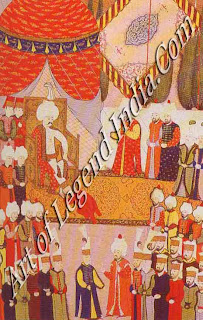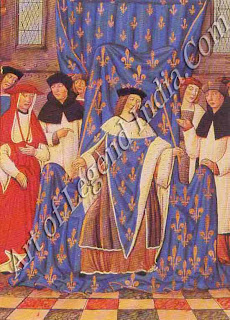A Year in the Life 1515
The
year 1515 saw the newly crowned French King, Francis I, more concerned with
winning glory in Italy than making political capital from the marital exploits
of Henry VIII's two sisters. Meanwhile, Francis' victory at Marignano and the
publication of Lives of Obscure Men showed up the weakness of the papacy.
Grunewald
and many of his contemporaries were becoming increasingly disillusioned with a
church that gave more attention to matters temporal than spiritual. In 1515,
the year the artist completed his Isenheim Altarpiece, another German attacked
the heart of the matter with the anonymous work entitled Lives of Obscure Men.
This notorious satire purported to be a series of letters written in support of
the Dominican monks who were attempting to suppress the study of Hebrew; but in
truth it attacked the ignorance and narrow-mindedness of the monks and the
corruption rampant in the Church. The book's popularity was one of many
manifestations of dissatisfaction with the state of the Church under the Medici
pope, Leo X. His swelling of the Vatican coffers through increased sale of
Indulgences to finance the political ends of the papacy and his own family, led
two years later to Luther's campaign against abuses, and ultimately to the
Protestant Reformation.

Hindsight
shows how significant these events were, but at the time dynastic politics
seemed far more important. Two incidents during the year involved England's
Henry VIII and his two sisters, Margaret and Mary Tudor.
TWO HEADSTRONG PRINCESSES
Margaret
Tudor had married James IV of Scotland who died at the battle of Flodden Field
in 1513. Her subsequent marriage to the Earl of Angus alienated the Scots
nobility and resulted in her being prevented from acting as regent and guardian
of the future James V. She fled to England in the autumn of 1515, arriving at
Henry's Court at London the following year.
Her
sister Mary had, in the meantime, been married against her will at the age of
18 to Louis XII of France. To her relief her ageing spouse breathed his last on
New Year's Day 1515 after 81 days of wedlock. The young widow could now hope to
marry the man with whom she already had a secret understanding Charles Brandon,
Duke of Suffolk. Despite a promise from Henry that she could marry whom she
pleased on Louis' death, Mary knew that it would be hard for him to give up
such a useful diplomatic tool as a marriageable royal sister.
Suffolk
was deputed to head the English embassy sent to France to congratulate the new
King Francis I on his accession. Matters were complicated for the lovers in
that Suffolk had promised his King that he would delay action until his return and
Francis was making advances to the young widow. Under pressure, Mary acted
quickly, telling Brandon that he must marry her immediately, in France, or not
at all. The erring couple was allowed to return to England and their union was
openly solemnized at Greenwich on 13 May.
 Suffolk
was supported during these difficulties by Henry's chief minister, Thomas
Wolsey, Archbishop of York who in 1515 was at the height of his career. Created
Cardinal by the Pope, later in the year he was made Lord Chancellor by Henry
VIII. Wolsey's Cardinal's hat was, in fact, a bribe from Leo X to ensure
English support of his alliance with the Emperor Maximilian and Ferdinand of
Spain against the new French King. At 22, Francis I dreamed of winning instant
glory in Italy, where previous French kings had several times seized and lost
the powerful duchy of Milan. To make good the French claim, Francis would have
to defeat the Swiss mercenary army supporting the incumbent Sforza Duke. Swiss
pikemen were generally regarded as the best soldiers in Europe.
Suffolk
was supported during these difficulties by Henry's chief minister, Thomas
Wolsey, Archbishop of York who in 1515 was at the height of his career. Created
Cardinal by the Pope, later in the year he was made Lord Chancellor by Henry
VIII. Wolsey's Cardinal's hat was, in fact, a bribe from Leo X to ensure
English support of his alliance with the Emperor Maximilian and Ferdinand of
Spain against the new French King. At 22, Francis I dreamed of winning instant
glory in Italy, where previous French kings had several times seized and lost
the powerful duchy of Milan. To make good the French claim, Francis would have
to defeat the Swiss mercenary army supporting the incumbent Sforza Duke. Swiss
pikemen were generally regarded as the best soldiers in Europe.
Francis'
first campaign was a brilliant success. His army pioneered a new route across
the Alps, to emerge behind the waiting Swiss, who hastily withdrew to Milan.
Then, at Marignano, a decisive two-day battle showed up Swiss neglect of
cavalry and, above all, artillery. A victorious Francis became Duke of Milan
and was confirmed in this title by the Emperor at the Treaty of Brussels the
following year. Pope Leo X was forced to come to terms with him at Bologna. It
was a splendid beginning to the reign but also the beginning of what proved to
be a generation of wasted French efforts in Italy.
Writer
– Marshall Cavendish
 Suffolk
was supported during these difficulties by Henry's chief minister, Thomas
Wolsey, Archbishop of York who in 1515 was at the height of his career. Created
Cardinal by the Pope, later in the year he was made Lord Chancellor by Henry
VIII. Wolsey's Cardinal's hat was, in fact, a bribe from Leo X to ensure
English support of his alliance with the Emperor Maximilian and Ferdinand of
Spain against the new French King. At 22, Francis I dreamed of winning instant
glory in Italy, where previous French kings had several times seized and lost
the powerful duchy of Milan. To make good the French claim, Francis would have
to defeat the Swiss mercenary army supporting the incumbent Sforza Duke. Swiss
pikemen were generally regarded as the best soldiers in Europe.
Suffolk
was supported during these difficulties by Henry's chief minister, Thomas
Wolsey, Archbishop of York who in 1515 was at the height of his career. Created
Cardinal by the Pope, later in the year he was made Lord Chancellor by Henry
VIII. Wolsey's Cardinal's hat was, in fact, a bribe from Leo X to ensure
English support of his alliance with the Emperor Maximilian and Ferdinand of
Spain against the new French King. At 22, Francis I dreamed of winning instant
glory in Italy, where previous French kings had several times seized and lost
the powerful duchy of Milan. To make good the French claim, Francis would have
to defeat the Swiss mercenary army supporting the incumbent Sforza Duke. Swiss
pikemen were generally regarded as the best soldiers in Europe. 













0 Response to "German Great Artist Mathis Grunewald - A Year in the Life 1515 "
Post a Comment